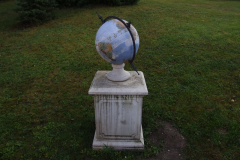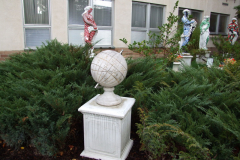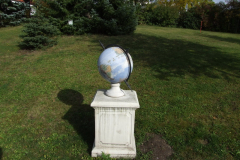Sine sole nihil sum
(I am nothing without the sun)
…is probably the oldest device for telling the time, which gives the true local solar time.This time determines the actual movement of the sun (or the shadow dropped by it). Because the movement of the right sun is uneven (the Earth’s rotation, although regular, but the circulation of the Earth around the Sun in an elliptical trajectory is uneven due to Kepler’s second law – velocity of the planet is shrinking, when the planet moves away from the Sun, and vice versa) is not entirely uniform nor the passage of true solar time.

Parts of sundials
- Stylus, Stylos
– shadow indicator, rod
Gnomon – indicator perpendicular to the plane of the dial.
- Polos
– pointer parallel to the Earth’s axis, ie. it always lies in the north-south vertical plane and forms an angle with the horizontal plane equal to the latitude of the post, irrespective of the orientation of the wall. Polos is used for vertical sundials in the form of rods usually ending with a ball – node. Time and calendar data will not determine the direction of the shadows, but only the shadow node position on the dial. - Nod, Nodus – bullet (or otherwise artistically crafted end of the pointer, eventually another mark on the indicator), whose shadow indicates the time or calendar data.
Sundials have one major disadvantage – they do not show the time when it is cloudy and at night. Therefore, in different historical periods, a number of operating hours on other principles were designed. They often benefited from a uniformly flowing happening – running water, pouring sand, burning candles or oil in the fixture. Adding a scale was enough to complete operating watches independent on the sun.
True solar time can vary from middle solar time shown by our watch, by up to +16 minutes (3 November), where the sundial precedes our watch at most hours, or -12 minutes (12 February), when the contrast right solar time is most behind central sun time.
The difference between the right and middle solar time is given by the equation of time (sometimes called time correction). The course of the time equation is presented graphically.

Value of the difference between the time indicated by sundial time and rhythm of our watches through the year.
Source: http://www.slunecni-hodiny.webzdarma.cz/princip_soubory/cas_rce.jpg
On the horizontal axis are the days of the year. The vertical axis is the time difference between the right solar time and the middle (evenly flowing). Four times a year (15April, 14 June, 31 August and 24 December) the equation of time is equal to zero. At times the sundial and the uniform time of our watches are identical. Positive values (15 April – 14 June and 31 August to 24 December) mean that the time measured by a sundial equals time ahead of our watches and negative values (14 June to 31 August and 24 December – 15 April) conversely, that the time shown on sundials is most delayed.

Another reason why the time value subtracted from a sundial differs from data on our watch, arises from the fact that the sundial usually indicates the true solar time of the local meridian. The figure of our watches on the contrary is based on the time band, ie the time corresponding to the time zone of the central meridian (in our meridian 15 ° east of Greenwich, which passes through towns such as Czech Oak or Jindrichuv Hradec). Individual moments (east, true solar noon, and sunset) at sites east of the meridian occur earlier, the stations west of it occur later.
So if we are one degree to the east from the 15th meridian (eg Great Mezirici), we have to subtract 4 minutes from sundial time. Analogically, we would have to add the same amount of time in the west (eg Příbram).
Given the earth turns round its axis about once every 24 hours, we can divide the world sphere into 24 parts using hourly circles, which will pass through the poles. As a full angle of 360 ° solar path during the day corresponds to 24 hours, it is an angle of 15 ° that accounts for 1 hour.
The development of industry and technology sectors, tourism, and other fields of human activity required an increasing need for use of more accurate methods of measuring time, and also placed greater demands on its convenient portability. The need for sundials gradually declined in relation to the improvement of mechanical roller-hours, but still sundials have long been used for example to adjust tower clocks. The agreement on the introduction of zone time in 1884 meant the real Twilight to the practical use of sundials. In our country, zone time was introduced on 1 January 1912.
Today, sundials rather have a decorative function than that of utility. At school, they also are a source of knowledge.

Source: http://www.astroama.com/hdsw_cz/pictures/pg-15.png

Anelemma is a curve in the shape of an eight, which is obtained by recording the position of the sun every day at the same time during the year. Pictured above are 44 separate exposures which were recorded on one video field to illustrate the regular, steady movement of the sun. In the foreground there are the ruins of ancient Nemea, a place where the Greek mythological hero, Hercules, performed the first of his twelve tasks.
Source:http://apod.nasa.gov/apod/image/0406/analemma2003_ayiomamitis.jpg
The most widespread are vertical sundials (at Gymnázium Cheb you can see the arch above the entrance to the school atrium). Very rare, but the more prized are spherical sundials in the shape of the globe. It is the most perfect and most beautiful Horologium.They really deserved being given the designation Royal sundial.
Unlike most watches, Globe ones are three-dimensional, precision ball-shaped. The globe is marked with both tropics, the equator, meridians, and dials. The horizon passes through the center of the globe and is indicated by a horizontal circle.

Royal sundials were previously placed in important places – castles, churches, monasteries, etc. They used to be a privilege of the rich or scholarly.





